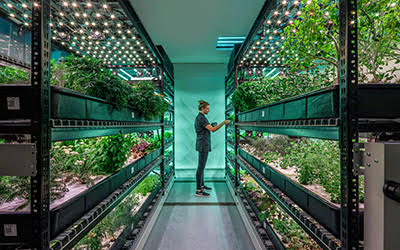Image

By: Layna Hayes

The following passage is reprinted from Rick LeBlanc's article in Sustainable Business titled "What You Should Know About Vertical Farming"
Vertical farming is the practice of producing food on vertically inclined surfaces. Instead of farming vegetables and other foods on a single level, such as in a field or a greenhouse, this method produces foods in vertically stacked layers commonly integrated into other structures like a skyscraper, shipping container or repurposed warehouse. Using Controlled Environment Agriculture (CEA) technology, this modern idea uses indoor farming techniques. The artificial control of temperature, light, humidity, and gases makes producing foods and medicine indoor possible. In many ways, vertical farming is similar to greenhouses where metal reflectors and artificial lighting augment natural sunlight. The primary goal of vertical farming is maximizing crops output in a limited space.
Vertical farming produces crops on shelves indoors, aiding in the problem of the growing demand for food and the decrease of farmable land. The method of vertical farming produces more food in smaller spaces in a sustainable fashion, using about 95 percent less water than traditional farming. With vertical farming, crops can be grown year-round, weather does not affect them, and there is less exposure to chemicals that can cause disease. But, there are some drawbacks to this process as well. It can be very costly, it relies heavily on technology, and does not allow for pollination. Vertical farming is becoming more and more ubiquitous and successful in countries like Japan, so it is proven to have benefits. As technology continues to develop, I think this could be a great way to ease the pressure farming puts on the environment.